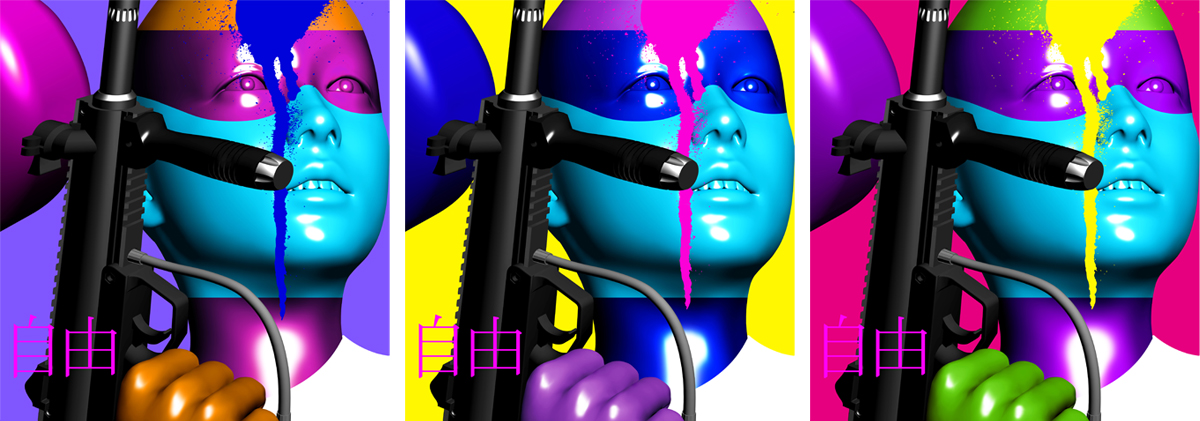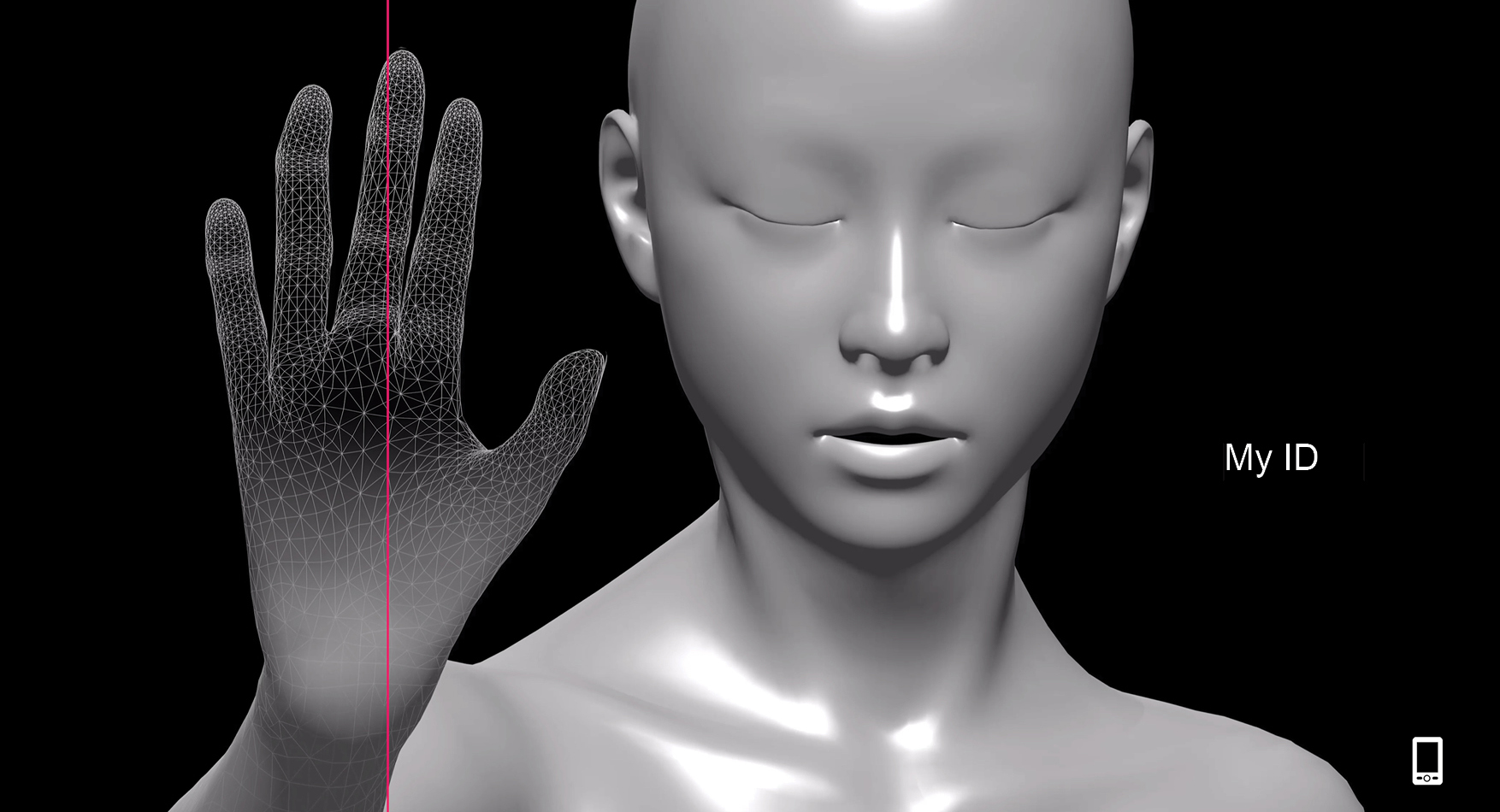The Art of Hybrid Neural Networks (HNN ART) is a cure for the fear of digital. Galina Bleikh and Elena Serebryakova
The current pandemic has unexpectedly been a catalyst for a process launched long before it began, namely, the use of the Internet as a medium for direct audiovisual communication between people. It is clear that by the beginning of the pandemic all the tools for this had already been created and widely used - Zoom, Skype, WhatsApp, etc. But it was in conditions of isolation that they became the only possible means of communication, education and employment for most people. Even ardent opponents of the digital revolution and computer haters were involved in using these resources. We can say that humanity has prepared in advance for life in a period of physical disunity, as if it knew about its approach.

Galina Bleikh & Elena Serebryakova. Paintball
But against the background of an unheard-of increase in the number of a wide variety of users, the collective unconscious began to generate fear and horror about the invasion of the all-seeing and all-pervading "number" into private life. This hysteria takes on a wide variety of forms - from the chilling idea of "universal chipping with a vaccine against the virus according to the insidious plan of Bill Gates" - to the panic fear of being "visible" and "recognized" always and everywhere, right down to your own bedroom, and, inevitably recognizing your mood and reading your thoughts. A term has also appeared that eloquently describes the situation: “digital concentration camp”.
The discussion of relevant topics flooded the Internet, and everyone is seriously involved in this discourse: the so-called “ordinary people”, politicians, human rights activists, scientists. Artificial intelligence, not yet having time to properly hatch from the egg, has already made itself a whole army of enemies around the world.
And what about art? How is it responding to the challenge posed to us by the digital revolution? We see that here, too, there is already a whole spectrum of relations between the artist and AI - from art projects based on the effects and capabilities of artificial intelligence, to the loud auction sale of a painting created by the "hand" of an artificial artist.
It is interesting to note that AI creates its artistic creations based on the analysis of already existing works of art, which it categorized as “art”. In terms of human consciousness, these works are a kind of "reflection" of the digital intellect on the culture created by people. By isolating the characteristic features inherent in the picture as such, and somewhat fancifully combining them into a new picture, the AI always follows the model already created before it, that is, it seems to be behind the artist's living thought, turned into the future. In this regard, AI “creativity” can still be defined as retro-oriented.
It is the artist's living thought, his intuitive and at the same time analytical approach that can change the picture of the relationship between a person and AI. Art working in the field of consciousness is able to create settings for their constructive, positive interaction based on the principles of partnership and “mutual understanding”. By appealing to both the sensual and the rational sphere of consciousness, artists today are already building a space for dialogue and creating conditions for living their personal experience of implementing such a partnership. Thus, art can become a tool to overcome the crisis in relations between AI and society.
We are confident that the objective vector of the development of civilization is tuned for the further interaction of man and technology, for the exciting expansion of the boundaries and possibilities of homo sapience. Humanity has engaged in auto-evolution, developing and increasing its potential on its own, no longer relying on nature. This allows us to talk about the "Eighth Day of Creation", when the creation itself creates itself anew.
Of course, contemporary art has firmly settled in virtual reality. Take photography, video, animation, 3D effects, chat art, blog art, Instagram, and more, for example. All of this expands the territory of art. And on this new territory you can plant a garden, or you can drown in a swamp. As always, the choice is ours.
What is HNN Art
We, artists Galina Bleikh and Elena Serebryakova, have created a new trend in contemporary art - Hybrid Neural Network Art (HNN Art). We define HNN Art as Science Art, which deals with the creation of art based on a hybrid interaction of biological and artificially created neural networks. HNN Art allows you to perceive this symbiosis as a whole world, rather than a fragmented set of functions.

Galina Bleikh & Elena Serebryakova. From the “Reincarnation Zero” project. Virtual Reality, KZ-gallery
We are pioneers in the study of our own joint creative activity using a machine resource, which we consider as a process described using the concept of a hybrid neural network (HNN). We have created the conditions corresponding to the mode of operation of a hybrid neural network (HNN), consisting of our own bioneurons and artificial computer nodes. An input is made up of the parameters and computer network content that we put into the system, an output is a model that corresponds to the language of contemporary art.
The term "hybrid" is understood by us as a creative system consisting of several integrated subsystems, each of which can have different presentation languages and output methods. Subsystems are combined with each other semantically and in terms of interaction with each other.
The hybrid creative system allows us as artists to achieve a synergistic combination of neural and symbolic models. Thus, the possibility of going beyond the limits of individual limitations and one's own “I” is realized.
Our bioneurons in the creative process are neural network nodes that are responsible for determining the direction of vector connections circulating within the HNN. These vector connections are the goals and objectives that we formulate in our creative work.
Artificial computer nodes supply to the neural network and process network red-made content that exists in the form of images, three-dimensional models, templates, time frequency, communication codes, semantic meanings, signs and symbols, color schemes, hypertext, actual references, media and blogging garbage ".
Duchamp wrote: “It doesn't matter who created the work: a certain Mr. N or someone else ... concept and selection are the criteria ...”
Duchamp inserted a urinal into the context of art, and we - a ready-made three-dimensional computer doll Mickey from the Poser program. And this is a kind of virtual red-maid for us. At the same time, in contrast to the urinal, in which the "content" does not linger, our doll is filled with meanings, resources, possibilities. Three-dimensional modeling allows you to create images that have typological characteristics, but are devoid of subjective states.
However, at the same time, the image we have created lacks the detachment of a unified virtual doll - it is warm and charming. The absence of individual traits in it, in an unexpected way, does not contradict the manifestation of the human animate principle.
Our method makes it possible to obtain a result, in the formation of which the hidden part of the neural network, which is a self-learning system, participates. Thanks to this, the hybrid neural network (HNN) gives an unpredictable result, which is the principle of creative activity in general.
Sometimes we sit on Skype all night, and in the morning we find that a new work is already ready. Born in the net ...
Today, our weightless consciousness began to wander around other worlds, and our tired body of flesh and blood remained at home. In new spaces, we gradually found a new body - light and smooth, with cute emotions painted on its surface. But then the moment came when we asked ourselves - where are we ourselves? Where are we from? They looked around and saw nothing.

Galina Bleikh & Elena Serebryakova. From the project "In Search of the Lost Body"
The mission of our art project is to model and prepare the mind for the breakthrough of virtual reality into our world, carried out by post-screen technologies.
There is one more aspect. It is interesting for us to show how the concept of "network", corresponding to the era of the Internet, begins to correspond to all areas of our life. Modern architecture uses 3D meshes to create macro geometry. We are faced with network commerce, network broadcasting, network advertising, etc. Our works are also projections of three-dimensional geometry, which is based on mesh, that is, a three-dimensional mesh. The network is an image of transpersonal consciousness that lies outside the individual. The 3D model is also based on a grid.
"Simulacrocentric" world
One of the most important challenges for modern civilization is the answer to the question of where scientific and technological progress is taking us. Revolutionary breakthroughs in information and biotechnology for the first time pose before us challenges that humanity has never had to deal with. This uncertainty inevitably causes people to feel confusion, fear of "dehumanization" and impending disaster. Is a person able to understand the world that he himself created?
Today humanity is experiencing a crisis of anthropocentrism. We make a bold assumption that the central figure of the future will not be a man, but a simulacrum (Baudrillard's term), and that culture will become simulacrocentric.
Artificial intelligence will learn more and more to "hack" people, to surpass them in skills that were previously considered exclusively human. He also possesses unique abilities that humans lack.
It is NOT our goal to demonstrate the technical capabilities of AI. We are NOT getting involved in the pursuit of its rapidly evolving capabilities and effects.
Our art-scientific project "Simulacrocentric World" builds a new type of communication corresponding to the changing world between a simulacrum, in our case a three-dimensional doll of Mika, and a person. We create conditions for gaining experience of mutual understanding, attunement with something or with someone else who is not you and is not like you.

Galina Bleikh & Elena Serebryakova. From the "Touch" project
As the creators of Hybrid Neural Network Art, we are engaged in adaptation to the dynamic changes of the world.
In this way, we contribute to entering the future on the principles of accepting it and overcoming fear in the face of artificial reality.
We believe that humanity is able to overcome difficulties if people learn to accept the new reality they have created.
I would like to tell you about the well-known experience delivered by prof. H. Ershon, - the test person is covered with a blanket over the body, while he sees the hand of a mannequin next to him being stroked. After a while, the subject's own hand begins to twitch, feel touches. This idea is based on teaching people with disabilities to feel the prosthetic arms and legs as tangible parts of their own body. That is, we are talking about the transfer of consciousness into an object.
As a matter of fact, we are doing this in our art project. The three-dimensional model is just an empty vessel into which you can “pour” any content. For example, transfer your consciousness to a plastic doll and thus get out of your own limitations and conditioning, unite with artificial reality into a single whole. This is what art dealing with images can provoke us to.